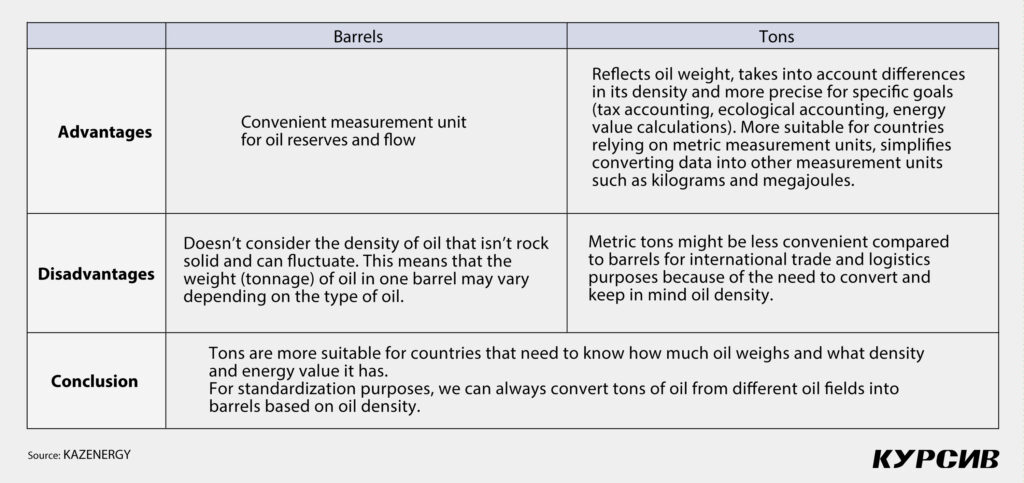As product-sharing agreements on Karachaganak, Kashagan and Tengiz are getting closer to expiring, new negotiations between Kazakhstan and foreign investors are looming ahead. We have to talk in the same language on these negotiations,” says Askar Ismailov, head of the PACE analytical company. Of course, he doesn’t mean the English language; he means the necessity of the Kazakhstani oil industry to switch from metric measurement units to barrels, a system that foreign investors are very familiar with. However, market participants and the Ministry of Energy of Kazakhstan do not support this transition to barrels.

Is it easy or hard?
For decades, Kazakhstan has been measuring its oil in tons, using barrels from time to time for rent taxation purposes, for example. In this case, it is crucial for Kazakhstan because the rent tax directly depends on oil prices on global markets where oil is usually measured in barrels.
To convert oil from metric tons to barrels, the barrelization coefficient is used. This rate might be different for oil produced on different oil fields. For example, this is true for oil produced by KazMunayGas (KMG), the national oil company in Kazakhstan that runs dozens of oil fields in different parts of the country. (Karachaganak, Kashagan and Tengiz are considered as alone-standing megaprojects.) The heaviest oil is produced at Karazhanbasmunay (coefficient of 6.68), while PetroKazakhstan produces the lightest oil with a coefficient of 7.75.
«To avoid any possible mistakes with defining the barrelization coefficient, you need to consider the thermal regime and density of oil (a rate defined with the help of special measuring devices deployed at the beginning of the export route). In summer, for example, oil isn’t as dense due to the high temperature of the air. Of course, you should ensure that your measuring devices always do their job correctly. I mean, thanks to these devices, we can measure oil in metric tons and then convert them into barrels. This is a complex process,» Ismailov said.
To address the issue, the expert offers measuring oil volume (in barrels), not its weight (in metric tons): «In this case, the volume in barrels is going to be the same throughout Kazakhstan.»
However, the Ministry of Energy has a different point of view on this. The agency believes that oil density and barrelization coefficient could change even within one oil field as physical characteristics of oil depend on formation pressure, oil and gas content in different layers and even weather conditions on the surface.
«This is why one barrel of oil can contain different amounts of oil as this rate depends on density. In other words, the current oil measuring system in metric tons is the most accurate,» the agency highlighted.
In turn, KMG noted that as long as oil quality certificates reflect their chemical characteristics there is no problem in calculating oil from tons to barrels and vice versa.

International practices
An additional argument Ismailov uses to support switching to the barrel as a measurement unit is that international exchanges and OPEC use it. (Even though Kazakhstan isn’t an OPEC member, it closely cooperates with the organization.) «All data from OPEC comes in barrels. Our Ministry of Energy then converts all this data into tons. Given that different oil companies have different barrelization coefficients, this process is too complicated,» Ismailov insists.
«Even though barrel units are used for oil trading on international markets, we apply both barrels and tons for evaluation of our oil reserves. For example, operators of the Karachaganak, Tengiz and Kashagan (KPO, TSO and NCOC, respectively) account for their oil in barrels and tons alike. The current standard requires us to keep records of oil in the pipeline system in metric tons,» KMG said.
According to NCOC, which is engaged in developing the Kashagan oil field, the transition to barrels has solid logical and practical ground, partially because in international practice oil is primarily measured in barrels.
«Nevertheless, the use of metric tons in Kazakhstan is more convenient for specific transactions and local settlements. NCOC has been conducting all its payments based on applicable requirements,» the public relations department of NCOC said.
Even though the company hasn’t elaborated on this idea, its financial reports include barrels of oil equivalent, tons and standard cubic meters.
The PR Department of Karachaganak Petroleum Operating (KPO) has refused to comment on the transition to a barrel-based measuring system and barrelization coefficient in KPO, citing the confidential nature of this information.
Tengizchevroil (TCO) hasn’t responded to Kursiv’s request to comment on the matter.
How to attract new investors
Islamov points out that oil output on many mature oil fields has been declining for the third year in a row. «I mean, we are reaching the point when three oil fields – Kashagan, Karachaganak and Tengiz – will account for the lion’s share of oil output in our country. All three oil fields are run by Western companies which measure oil in barrels,» he explained, suggesting speaking with key partners on their language – the language of barrels.
The expert believes that it would be impossible to reach effective interaction with investors when a hosting side is trying to make it difficult from the very start.
«I’ve seen during a meeting in Kazakhstan that information presented by our Western partners was in barrels and then our officials were trying to convert this data into metric tons using whatever was available. All of this makes negotiations a more complicated process. Given that the president calls for simplifying procedures for investors, I think Kazakhstan should use language that investors can easily understand,» Ismailov underscored.
These changes must be implemented by the Ministry of Energy, he believes. However, the agency is citing the law on measurement units. According to this law, it is legal to use in Kazakhstan any measurement units under the International System of Units adopted by the International Bureau of Weights and Measures and recommended by the Organization of Legal Metrology in a way set by an authorized body. In other words, measuring oil in metric tons is codified in the country’s legislation.
The metric system is officially adopted not only in Kazakhstan but rather in almost all countries all over the world. «There are not many countries along with the U.S., Liberia and Myanmar that use barrels. However, because the U.S. is the biggest consumer of oil on the planet, all other countries produce oil in tons and sell it in barrels,» KMG said on its website.
According to Kazenergy, international markets, the North American market, first of all, use the American system called Field. If Kazakhstan wants to switch from metric tons to barrels to assess its oil reserves, it has to switch to the Field system for calculating the formation volume factor. To do so, the country would be expected to change all measurement units for length, volume, pressure and density, namely by introducing pounds, psi (pound per square inch) and so on.
«You have to be able to count extractable natural reserves accurately to attract foreign investments. Apart from reserves, the tax regime, preferences and sales channels are the most important factors for investors,» Kazenergy said.
This means that measurement units have never been the central point of concern. This is rather a technical issue. «It just cannot affect the size of any reserve as well as the accuracy of this data,» the association added.
Ismailov pityingly says that Kazakhstani officials tend to block almost all initiatives that come from anybody else but them to avoid potential difficulties.
«Crucial decisions are made only when they come as an instruction from the government. This is why, perhaps, we need to appeal to the president’s administration or even to the president himself. If he says the same in the form of an order, they would execute this,» the expert noted.

Secret ingredient
According to Askar Ismailov, the Ministry of Energy of Kazakhstan uses the barrelization coefficient of 7.3 to convert metric tons into barrels.
«It’s wrong to use one coefficient for all our oil because it’s different: it’s lighter in Karachaganak and heavier in Tengiz and Kashagan,» Ismailov says.
However, the Ministry of Energy denies it uses the barrelization coefficient, insisting that all its reports rely exclusively on metric tons.
When the agency was asked how it communicates with OPEC and transmits data about the discharge of its commitments concerning oil production, the Ministry of Energy said the following:
«We do not provide them with any information. They tell us how many barrels we have produced. We’re also curious about what kind of methodology they use because we only use metric tons. If you take a closer look at the coefficient (the barrelization coefficient OPEC applies toward Kazakhstan), it is 7.55. But their equations aren’t clear for us. We haven’t provided them with this coefficient.»
OPEC hasn’t immediately responded to a request for comments on the issue of setting the barrelization coefficient for Kazakhstan.

